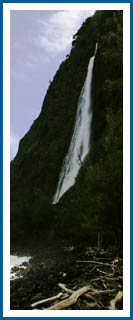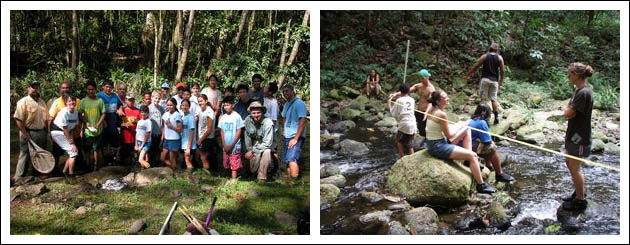
 |
 |
Welcome to the Student Section of the Waipi‘o Valley Stream Restoration Study where YOU are the scientist!You will be conducting a scientific study of Lālākea Stream over the course of several weeks. During that time, you will:
It is up to you to learn all about Hawaiian streams in order to conduct this investigation that measures the effect of restoring a stream. You’ll have a great time on the field trips to Waipi‘o Valley, making new friends and experiencing new things. Get your feet wet by going on a Virtual Stream Visit! My name is Ron Englund and I am a stream scientist at the Bishop Museum. I would like to invite you and your classmates to join Bishop Museum and other scientists in an important landmark study in Waipi‘o Valley. We will be conducting the first-ever study of completely restoring a Hawaiian stream to natural flow conditions, and we can use your help. Since the scientists are only able to go to the stream site occasionally, groups of students from your school and other schools will participate in the study and help us collect and analyze data. Let's start by reviewing some background on this project.
Over 80 years ago, Hi‘ilawe Stream, like many other streams in Hawai‘i, was diverted to be used for irrigation, or watering, sugar cane plantations. That means that a concrete barrier was built to stop the water from flowing straight down its natural course into Waipi‘o Valley and instead flow to the side into miles of sugar cane fields. While the water was useful for growing sugar cane, the natural ecosystem and communities that depended on that stream were changed and not for the better. The concrete barrier, or "diversion", had been built at 2000 ft. elevation, high above the valley. With the reduction of water, there were no longer two waterfalls at Hi‘ilawe, but only one. Not only was there less water flowing, but it flowed slower and was warmer which affected the plants and animals that live in the stream. Now that sugar cane is no longer commercially grown in that area, it was decided to remove the diversion and restore the stream to a natural and free-flowing river. The Lālākea stream restoration, a historic event, took place in July 2004. The purpose of our study is to investigate how the stream changes when the water is restored. How much more water will there be? Will the water quality and temperature change? Will the kinds of animals and the plants living in the stream change? How will their habitats be altered? Groups of scientists and students will be going to the stream to collect data at many different parts of the stream. There will be over 10 scientists involved in the study from Bishop Museum and other institutions. About 60 students from the Big Island will participate each year. The students are 7th graders from Kamehameha School in Kea‘au and middle-schoolers and high schoolers (5th-12th grades) from Kanu o ka ‘Aina school in Waimea. 
The first groups, in March and April 2004, will be investigating what the stream is like now, before the water is restored. This is called the "baseline study" because it provides a basis for comparing to data collected later after the water is returned. Starting in July 2004, data will be collected as part of the “monitoring study”. Groups of students and scientists will visit the stream several times each year to collect data in the same locations, using the same methods as the baseline study. This will allow you to make comparisons and determine what effect the restoration has had on the stream. |
|
| Copyright © Hawaii Biological Survey, Bishop Museum Site last updated January 2010 |
||